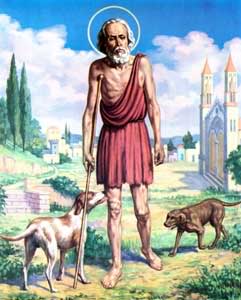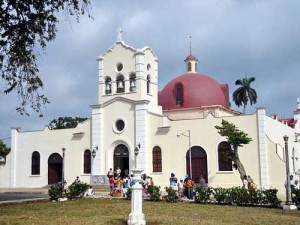 SAN LÁZARO, EL DE LAS MULETAS Y LOS PERROS.
SAN LÁZARO, EL DE LAS MULETAS Y LOS PERROS.
Una de las manifestaciones más populares de fervor religioso en Cuba es la peregrinación anual al Santuario Nacional de San Lázaro, creyentes que le dan a este santo una gran generosidad para conceder peticiones personales y milagros, a menudo asisten masivamente a pie o en cualquier medio. Transporte a este lugar el 17 de diciembre, festividad de san Lázaro. En ese día, y especialmente en la víspera, los fieles tienden a cumplir sus promesas o establecer otras promesas, que pueden ser, precisamente, la caminata difícil desde diferentes partes de la capital.
En Cuba después de la Virgen de la Caridad del Cobre, San Lázaro es el santo más venerado, casi siempre ligado a la santería. Tiene un santuario a las afueras de la Habana. La peregrinación de diciembre es multitudinaria, una marea humana de mas de 10 kilometros de largo. Durante todo el día y más aún de noche… porque a las 12 de la noche todos quieren estar ante el santo, cosa imposible, evidentemente.
En San Lázaro se da la confluencia de dos personajes distintos: Lázaro, hermano de Santa María de Betania (ya hoy no identificada con María Magdalena) y Santa Marta, eran amigos de Jesús y le invitaban a su casa en Betania, cerca de Jerusalén, donde era amado y acogido. Señal de su intimidad con Cristo es el hecho de como Jesús, aún yendo a resucitarle, luego de morir Lázaro, lloró, al contemplar el duelo de María y Marta. Uno de los milagros más grandes de Cristo fue, precisamente el traer de nuevo a la vida (que no fue resurrección) a Lázaro. Hasta aquí, lo único certero que se puede afirmar de este personaje amigo de Jesús y Lázaro, el pobre mendigo de las parabolas de Jesus. Los vemos por separado:
San Lázaro, el de las llagas, las muletas y los perros, tiene su origen en un pasaje de los Evangelios.
Según el Evangelio de San Lucas, Jesús, que solía hablar en parábolas a las gentes, dijo un día a los fariseos: “Había un hombre rico, que se vestía de púrpura y de lino fino, y hacía cada día banquete con esplendidez. Había también un mendigo llamado Lázaro, el cual estaba echado a la puerta de él, deseando hartarse de las migajas que cayeran de su mesa, lleno de llagas, y aun los perros venían y le lamían las llegas.
Y aconteció que murió el mendigo, y fue llevado por los ángeles al seno de Abraham: y murió también el rico, y fue sepultado.
Y en el infierno alzó sus ojos, estando en los tormentos, y vio a Abraham de lejos, y a Lázaro en su seno. Entonces él, dando voces, dijo: Padre Abraham, ten misericordia de mi, y envía a Lázaro que moje la punta de su dedo en agua, y refresque mi lengua; porque soy atormentado en esta llama.
Y díjole Abraham: Hijo, acuérdate que recibiste tus bienes en tu vida, y Lázaro también males; mas ahora este es consolado aquí, y tú atormentado. Y además de todo esto, una grande sima está constituida entre nosotros y vosotros, que los que quisieren pasar de aquí a vosotros, no pueden, ni de allá pasar acá”.
Sin embargo, la religión católica jamás santificó al mendigo de la parábola bíblica. Para ésta el único santo de ese nombre es San Lázaro Obispo, el cual aparece siempre en las imágenes sin llagas, tocado con una mitra y cubierto con una capa conforme a su jerarquía eclesiástica.
Hay que irla a buscar a la equivalencia que los negros lucumíes persiguieron en sus dioses africanos con las imágenes cristianas. Para ellos personaje evangélico era Babalú-Ayé, el “orisha” que cura a enfermos y protegía a los pobres. Y con este carácter colocaron su imagen en los altares que construían en sus cabildos y lo popularizaron. Babalú-Ayé en el sincretismo se le compara con San Lázaro (17 de Diciembre).
 SAINT LAZARO, THE ONE WITH THE CRUTCHES AND DOGS.
SAINT LAZARO, THE ONE WITH THE CRUTCHES AND DOGS.
One of the most popular manifestations of religious fervor in Cuba is the annual pilgrimage to the Sanctuary of San Lazaro, believers who give this saint a great generosity to grant personal requests and miracles, often attend massively on foot or in any medium. Transport to this place on December 17, festivity of San Lázaro. On that day, and especially on the eve, the faithful tend to fulfill their promises or establish other promises, which may be, precisely, the difficult walk from different parts of the capital.
In Cuba after the Virgen de la Caridad del Cobre, San Lazaro is the most venerated saint, almost always linked to Santería. It has a sanctuary on the outskirts of Havana. The December pilgrimage is multitudinous, a human tide of more than 10 kilometers in length. Throughout the day and even more at night … because at 12 at night everyone wants to be before the saint, which is impossible, obviously.
In San Lázaro there is the confluence of two different characters: Lázaro, brother of Santa María de Betania (now not identified with María Magdalena) and Santa Marta, were friends of Jesus and invited him to his home in Bethany, near Jerusalem, where he was loved and welcomed. Sign of his intimacy with Christ is the fact of how Jesus, even going to resuscitate him, after Lazarus died, cried, contemplating the mourning of Mary and Martha. One of the greatest miracles of Christ was precisely the bringing back to life (which was not resurrection) to Lazarus. So far, the only certain thing that can be said of this character friend of Jesus and Lazarus, the poor beggar of the parables of Jesus. We see them separately:
San Lázaro, that of sores, crutches and dogs, has its origin in a passage from the Gospels.
According to the Gospel of St. Luke, Jesus, who used to speak in parables to the people, said one day to the Pharisees: “There was a rich man, who dressed in purple and fine linen, and made feast every day with splendor. also a beggar named Lazarus, who was lying at his door, wanting to be fed up with the crumbs that fell from his table, full of sores, and even the dogs came and licked him out.
And it came to pass that the beggar died, and was carried by the angels into the bosom of Abraham: and the rich also died, and was buried.
And in hell he lifted up his eyes, being in torments, and saw Abraham afar off, and Lazarus in his bosom. Then he, crying out, said: Father Abraham, have mercy on me, and send Lazarus to dip the tip of his finger in water, and cool my tongue; because I am tormented in this flame.
And Abraham said to him: Son, remember that you received your goods in your life, and Lazarus also ills; but now he is consoled here, and you are tormented. And besides all this, a great chasm is constituted between us and you, that those who want to pass from here to you, can not, nor from there to pass here “.
However, the Catholic religion never sanctified the beggar in the biblical parable. For this the only saint of that name is San Lazaro Obispo, who always appears in the images without sores, touched with a miter and covered with a cloak conforming to his ecclesiastical hierarchy.
What is the cause then of devotion so widespread in our country of the figure of the lacerated beggar?
It is necessary to look for it in the equivalence that the Lucumian blacks persecuted in their African gods with the Christian images. For them evangelical character was Babalú-Aye, the “orisha” who heals the sick and protects the poor. And with this character they placed their image on the altars that they built in their town councils and popularized it. Babalú-Aye in syncretism is compared to San Lázaro (December 17).
Agencies/ Wiki/ Various/ Internet Photos/ Arnoldo Varona/ www.thecubanhistory.com
THE CUBAN HISTORY, HOLLYWOOD.









